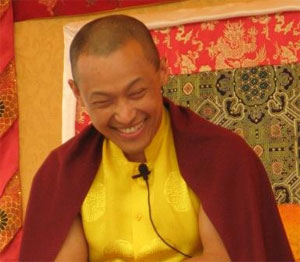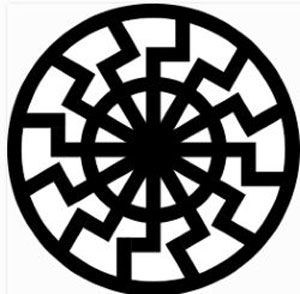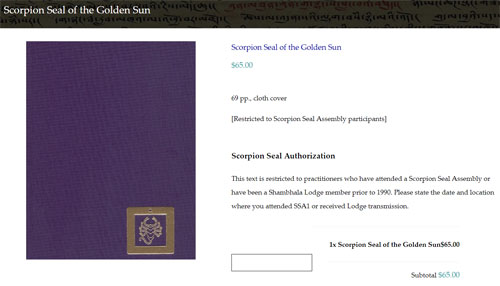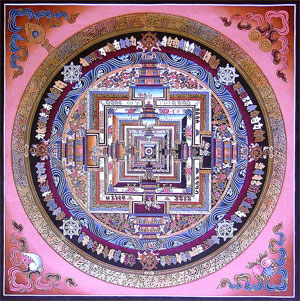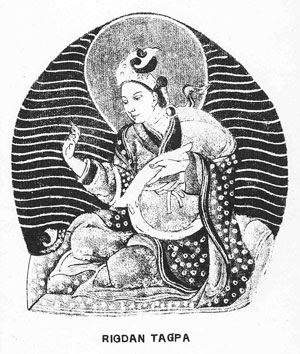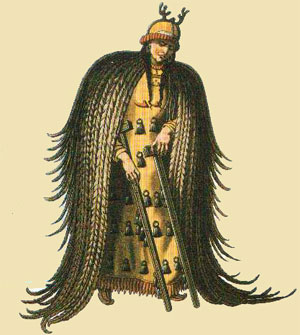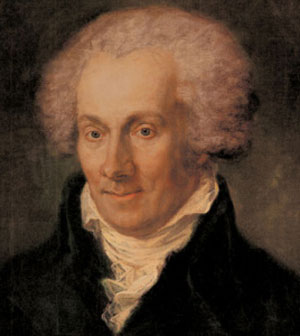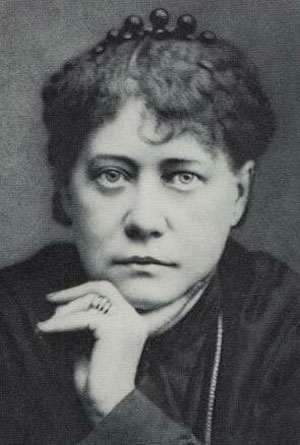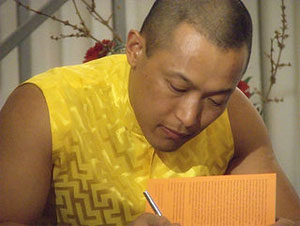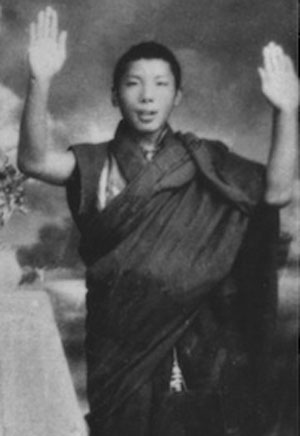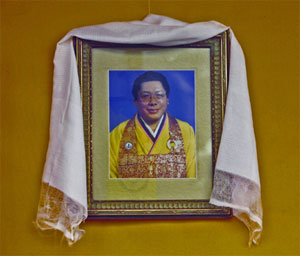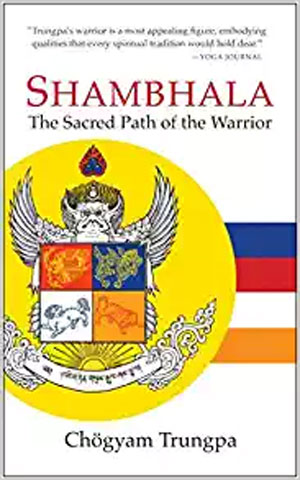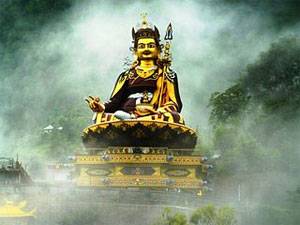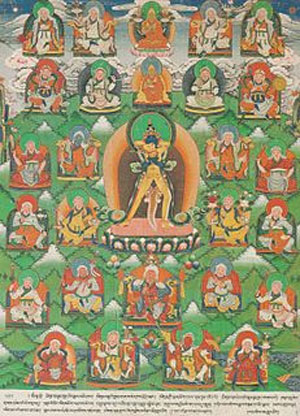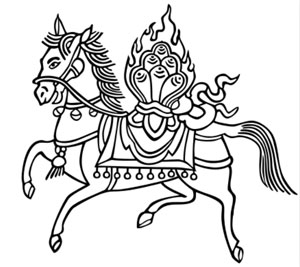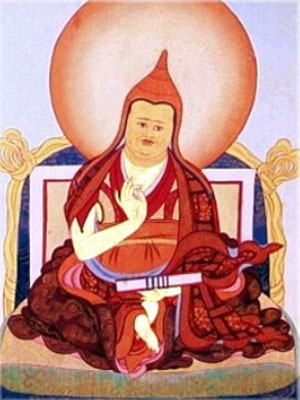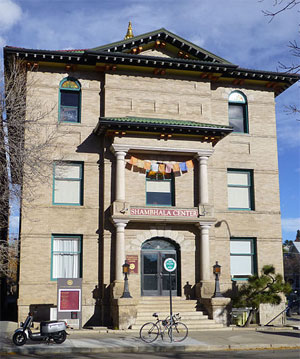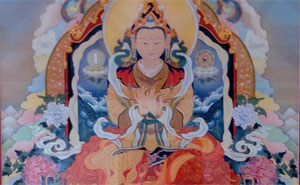Keeping Alive the Transmissions of the great Vidyadhara, Chögyam Trungpa Rinpocheby Bill Karelis
copyright 2008
NOTICE: THIS WORK MAY BE PROTECTED BY COPYRIGHTYOU ARE REQUIRED TO READ
THE COPYRIGHT NOTICE AT THIS LINK BEFORE YOU READ THE FOLLOWING WORK, THAT IS AVAILABLE SOLELY FOR PRIVATE STUDY, SCHOLARSHIP OR RESEARCH PURSUANT TO 17 U.S.C. SECTION 107 AND 108. IN THE EVENT THAT THE LIBRARY DETERMINES THAT UNLAWFUL COPYING OF THIS WORK HAS OCCURRED, THE LIBRARY HAS THE RIGHT TO BLOCK THE I.P. ADDRESS AT WHICH THE UNLAWFUL COPYING APPEARED TO HAVE OCCURRED. THANK YOU FOR RESPECTING THE RIGHTS OF COPYRIGHT OWNERS.
Since He had lost the reality of virtue, it appeared as if its semblance was become more valuable.
-- The Monk: A Romance, by Matthew Lewis
His Holiness Dilgo Khyentse Rinpoche clearly stated in 1990 that there is no one in our sangha at the level of realization of the great Vidyadhara, Chogyam Trungpa Rinpoche. And how could there be—since the Vidyadhara was, indisputably, a Mahasiddha? Not only Westerners, but many of the community of Tibetan practitioners of the Dharma, including the tulkus, especially those with contact with the West, or from Kham in Tibet, believe he was
greatly enlightened. His Holiness Dilgo Khyentse also said of the Vidyadhara that “the son has surpassed the father,” meaning that the Vidyadhara’s enlightenment surpassed his own. This is saying something, as His Holiness is revered among all the sanghas; he served as the supreme Head of the Nyingma lineage, educated dozens of young tulkus, and gave teachings to the 14th Dalai Lama. If the Vidyadhara was greater than he, then the Vidyadhara was
very great indeed.
I was present once with Kyabje Tulku Urgyen Rinpoche, whose
realization was so great that the Sixteenth Gyalwa Karmapa prostrated to him, even as Tulku Urgyen regarded the Karmapa as his own guru–when Tulku Urgyen was given a Tibetan copy of the Sadhana of Mahamudra, one of the Vidyadhara’s terma. Tulku Urgyen remarked, “The person who wrote this must have been
an amazing being.”
From the discoveries of Karma Senge Rinpoche, the Vidyadhara’s nephew, in Tibet,
it has recently come to light that the Vidyadhara
manifested as a tertön from the age of about eight.
The incredible texts and practices he discovered during that period, such as Ati yoga practices, are now being translated and transmitted.
I once heard Ato Rinpoche say that the Vidyadhara was
so fearless that he used to scare the other tulkus.
My calligraphy teacher, Eiichi Okamoto, at one time remarked to me that the black in the Vidyadhara’s calligraphies is somehow “blacker” than others’. To me, and to many,
the Vidyadhara’s calligraphy alone speaks volumes of great depth.
And so the reports go of
the Vidyadhara’s countless manifestations. Each of us has his or her favorite stories about him, no doubt—all pointing in the direction of his
inconceivable enlightenment.
Literally millions worldwide have encountered the Vidyadhara through his books–that is, through the power of the truth they convey. And those book sales continue strong year after year, after thirty years or so, with no promotion. I understand that several of them have sold about a million copies each. They will without doubt define the direction of the Dharma worldwide for hundreds of years.
But it is not, of course, the number of books sold, nor other objective standards, which tell
the depth and the breadth of the story. We, the Vidyadhara’s students, most of all, know
his greatness to be expressed in vastness of his vision and profound realization, appearing personally before each of his students in a different light, but always
the epitome of great kindness and strength. Since we met him personally, we have no doubt. He was, and still is a second Padmasambhava–the one who opened and continues to open the West to the genuine Dharma.
The extent of the impact of his teachings is impossible to measure, now or in the future.
In fact, everything about the Dharma we understand,
every wakeful form we have,
every breath of uplifted spirit expressed in mudra, every manifestation of enlightened society from which we benefit, is due to him. There is no one in our sangha who can say this is untrue of themselves, including those who never met him; for the newly arrived among us, all the teachers are the Vidyadhara’s students, or students of his students. If he were not what he was, if he did not do what he did, we would have no living lineage, no centers, not the upayas, nor the environment, nor the confidence, nor the view that we are so fortunate to have inherited.
He is truly haunting us, in the best and most pervasive sense. We are nothing without his manifestation, example, command and transmission. This is literally true.
The words of a Mahasiddha, and his instructions, the places he inhabited, how he conducted himself,
his very clothing and the relics of his body, are regarded as inviolable in the Buddhist tradition. As an example of this reverence, at a teacher’s gathering at the 1999 Vajradhatu/Shambhala Seminary, the Sakyong Mipham Rinpoche said that we should not change “one word” of the Vidyadhara’s teachings, and compared him to the omniscient Longchen Rabjam, the great expositor of the Nyingma tantras, in this regard.
The loss of blessings and wisdom associated with changing or otherwise losing the instructions and forms left behind by such a one as the great Vidyadhara, Chögyam Trungpa Rinpoche, would be irreplaceable, and sad beyond bearing. It would be a tragedy for humankind, owing the Vidyadhara’s pioneering role in bringing Eastern wisdom to the modern world. It is our task, as his students, trusted by him to propagate his lineage, to prevent this decline in his teaching stream, and to preserve the forms he left us, as well as to carry the oral tradition in our own beings.
The confidence about which he taught so thoroughly
applies most profoundly to this last point. He said that one doesn’t have basic goodness—one is basic goodness. We are that. If we feel we are not, then we have not understood. But someone must have pointed it out to us for us to know this, even though it is in our being. We also communicate this to others, whether we have a big project to do so, or whether we are just going to the grocery store.
Nonetheless, even though we may carry the teachings in our person, in order to give to others what was given to us, we need relative means. Those means are his bequest to the world. Surely we must keep intact and alive not only his spoken and written words, but also the forms and symbols he conveyed in all the realms of speech and body, which also point to his mind transmission, so that future generations, hundreds of millions of beings, may benefit from his enlightened activity. Obviously, that inheritance must be kept alive and pure, as close to its original form as possible.
Everything he created must be noted; every detail which is related to form, every literal instruction, every bit of advice, every flash of prajña he manifested, every thing he conveyed to each of us personally, must be carried on, in whatever way we are able to do so. This is for our own sake–at the very least for the sake of our self-respect–as well as for the world. And it must be done with meticulous attention to detail. Overall, this is a huge task, which no one person can accomplish; fortunately, there are many, many of us, each with our own particular piece of the puzzle. If each of us contributes that piece, that larger picture will become apparent, surely.
As he said, if we don’t do it, who will?
Some say that forms always change, and so changing the detail of our inheritance from the Vidyadhara makes no difference, if we preserve the spirit. This is a naïve view of how the genuine Dharma is actually transmitted on the relative level. In practice, it is too laissez-faire; and it misses an essential point of Dharma. There is a necessary relationship between the trangdon, or literal transmission of the Dharma, and the ngedon, the actual meaning. The trangdon is the way the Dharma is communicated on the relative plane. The real meaning depends on literal detail to be understood, unless one is capable of transmitting mind to mind, or through wordless signs and symbols—and even the sign transmission requires detail. Since most of us do not yet enjoy the higher levels of perception, or, even if someone among us does, since others in the future may not, the Vidyadhara left us means by which to convey the true meaning of his teaching stream. Thus it is that he gave specific instructions, and thus it is that he left behind specifically designated forms. His instructions and forms are precious trangdon, invaluable upayas and media for enlightened mind to move into the future, through the vehicle of the present moment. It takes a siddha to have created such amazing forms as he did, and to have evolved such instructions. It is something an ordinary being cannot do with the same power, profundity and effect. His instructions and the forms he created are
special, very special, beyond special—they are priceless.
He did not do these things arbitrarily. His enlightened activity and capability were and are
so accurate and far-reaching, that following the detail of his instruction carries
profound implications, blessings and potential realization for the practitioners lucky enough to receive them. I am not making this point up out of hope for permanence, or a quasi-Talmudic rigor, or some kind of conservative bias—it is the traditional Buddhist view of
the magnificent and profound bequest of one with such a great enlightened manifestation as the Vidyadhara. For example, to this day we practice the Four Foundations of Mindfulness as they are taught in the Satipatthana Sutta of the Buddha. If we cannot practice or do not understand that Sutta, as practitioners, we would do well not to attribute our disconnection to a fault in the Sutta itself, or to a flaw in the Buddha’s teachings generally, and especially we would do well not dismiss the original words as inapt or random. We do well to try to make the meaning evident through study and practice of the original teachings, with updated commentary. The only doorway into understanding the meaning of the Four Foundations of Mindfulness as taught by the Buddha is reverence and respect for the words of
that amazing text, along with reliable commentary, which, traditionally speaking, may be composed by a realized being or a great scholar. Otherwise, we cannot absorb them fully into our being, because we are obstructed by some kind of concept, perhaps in the form of a subtle grudge or sense of competition with the teachings.
When Khenpo Tsütrim Gyamtso Rinpoche taught the higher tantras at Karmê-Chöling throughout the 1990’s and into the 2000’s, he changed a few sentences which he felt were subject to clerical error in the Tibetan text, based on his unsurpassed scholarship and realization of the meaning of the words; but, besides this enlightened editing, he did not change one iota of the original tantras and later shastras. He made comparisons to other tantras, and he contributed his own dohas [realization songs], but as far as the texts being studied, he simply commented on those incomparable works, with a very light touch. That is the genuine tradition. The ur-texts and the great commentaries by enlightened masters stand on their own. The students trust in receiving those teachings in their purest, undoctored form.
We must hope and expect that millions of sentient beings, now and in the future, have faith in and will have faith in the instructions and forms the Vidyadhara laid out. These individuals’ credulity in the guidelines depends in turn on their faith that such guidelines are being passed on to them properly—in both the letter and the spirit accompanying their original transmission.
It is worth noting, also, that a distinguishing characteristic of the Mantrayana or Vajrayana method is to follow the literal instructions of the guru. So the detail takes a great deal of significance from the Vajrayana point of view. It relates directly to the transformation of one’s relative world. For example, at the Vajrayogini Abhiseka in 1996 at Shambhala Mountain Center, the Ven. Tenga Rinpoche, who served as the Dorje Loppön of Rumtek Monastery, whom the Vidyadhara called, “one of the truly joyful ones”—and who bestowed the Abhiseka-said we should not change an iota of the Vidyadhara’s instructions regarding any aspect of Vajrayogini practice. It was not a casual remark. There is no question in my mind that Tenga Rinpoche’s direction includes doing the practice by numbers, rather than by time, as Shambhala International now permits. Also, I believe it is safe to assume that Tenga Rinpoche, would extend this admonition to Chakrasamvara practice, as well as to the Karma Kagyu Ngondro, both of which again have recently been reworked by the Shambhala International Office of Practice and Study, on the advice of some Acharyas.
The change in Chakrasamvara requirement is based, once again on the perception of some Acharyas, that the practice has been too hard. The reasoning largely relies on the demographic observation that not everyone has finished the practice. But only about 50% of the people who began Karma Kagyu ngondro within our lineage have finished it, and about 50% of the people who have taken Vajrayogini Abhiseka have finished it, and about 50% of the participants in Shambhala Training Level I go on to Level II (this is an international statistic, that holds nearly everywhere), and about 50% of the people who take Level II make it to Level V, and only about one in seven people who enter a Shambhala Center return, and about one in seven of those who return actually stay into the future, and so on. These statistics are not demonstrably founded in the quality of programming, or practice content, or sitting time required, or any other identifiable external factor. They do not at all necessarily indicate there is something wrong. Perhaps, in the end, it is better to have encountered something challenging and have met that challenge somewhat, than to have encountered something easy and to have accomplished it. In the former case, perhaps, one learns more by experiencing some kind of endlessness and frustration of expectation. Who can say? Surely the karma of encountering the genuine article is profound. Yes, programming should adapt to people’s circumstances, but we should be very careful not to project our own habits and interpretations when we are adapting the reliable forms of the proven historical tradition.
Since Chakrasamvara practice as handed down to us has led to enlightenment of many adepts from the time of Tilopa (and before) to the present, somehow making it easier to finish the recitation practice seems inadvisable. Furthermore, the people I know who have finished this practice, as given us by the Vidyadhara, noticeably carry a level of shinjang, clarity and sanity which marks
the path of solid practice. Personally, while I found that doing the full Chakrasamvara retreat of approximately three-and-a-half months challenging in the extreme, mainly owing to the number of hours one needs to practice each day, I also found that such retreat reaches to a level of the psychology which cannot be reached in group practice, daily practice or by lesser exertion in seclusion. Our practice tradition, particularly on the Karma Kagyu side, is famously one of
“rock meets bone in insight.” Where else will this occur if not in Chakrasamvara retreat? All in all, it seems very necessary to warn the sangha about a change like this one to the Chakrasamvara guidelines, so that people may exercise intelligence in deciding their own direction.
Another change, about which I have recently been told (but did not read myself) is that it is no longer required to complete the Four Karmas Vajrayogini Fire Offering in order to attend Chakrasamvara Abhiseka. Why not? Would it be such an inconvenience? The Four Karmas Fire Puja is one of the noteworthy markers on our path.
I am making these points about our Karma Kagyu practice stream, not to disrupt the faith of new students, who may be following Shambhala International’s recent guidelines. If someone has faith in these guidelines, because they come directly from Sakyong Mipham Rinpoche, and/or his representatives, and carry the blessing of the lineage, that is a wonderful thing. As stated, following the literal instructions of the guru forms the core of our lineage tradition, and, reputedly comprises the road to enlightenment. Faith of that kind is surely only good. I wholeheartedly support the paths of these individuals and their devotion to the instructions they receive, and I truly admire them for it. I do not feel they should feel badly about, or have doubt in their decision to follow the changed guidelines.
Still, the point about the Vidaydhara’s instructions being bypassed, or otherwise amended, may be helpful for the students wishing to follow them, once they know what they are. If one does not know what they are, then one is deprived of the choice to follow them. All should understand the implications of the decisions they make, with adequate background information—ideally before they make the decision, but also, in the absence of advanced notice, at least at some point. I do not believe that adequate information has been generally available from the Shambhala International Office of Practice and Study, which seems bound by loyalty and good intention, and perhaps wisdom, to present a simple, doable version of the path to the students. Therefore, I am initiating this discussion, because perhaps the full implication of these decisions has not been made clear. There is no blame, but the full facts should be known.
Nor need there be conflict in the sangha whatsoever over such differences in practice instructions. I don’t think it is appropriate to become angry over such differences or the revelation of such differences, for example. It is a private decision in a person’s practice path whom they seek to trust, and what instructions they seek to follow. There is room for different ways. Certainly there should be accommodation in Shambhala International for the paths the Vidyadhara laid out, side by side with whatever paths the Sakyong Mipham Rinpoche is laying out, where they differ. Clearly, there are some significant changes between the Vidyadhara’s guidelines and the Sakyong’s; and so, just as clearly, there are now parallel, as well as divergent paths. So far, Shambhala International has never taken the position that the Vidyadhara’s original instructions should not be followed, and one has no reason to expect that the organization would take that step. Therefore, following the Vidyadhara’s instructions falls within Shambala International’s practice and study guidelines, and, I hope and believe, always will.
In terms of people receiving help with following the Vidyadhara’s literal Karma Kagyu path, if they choose to do so, there are hundreds if not thousands of his students, authorized instructors at every level, who can help a student upon request. I would personally be available to take such an email or phone call, and to assist in connecting any student seeking this guidance with a local instructor qualified to give it.
Another example of a change in curriculum and practice is in the realm of shamatha practice. There is new emphasis on a form of shamatha practice, which does not link easily to non-conceptual vipashyana as the Vidyadhara taught it. And the non-conceptual vipashyana the Vidyadhara taught he also presented as the basis for the Vajrayana path; in addition, he said it is that which threads the whole path from beginning to end. And, indeed, the shamatha/vipashyana instructions he left us act as a bridge to Mahamudra. A great translator, belonging to a cousin lineage, asked me a few years ago, what has happened with the Vidyadhara’s basic meditation instruction? I answered I thought there was no contradiction between it and what the Sakyong Mipham Rinpoche has taught. I have presented about twenty-three weekend seminars on the Sakyong’s shamatha presentations, so I hope I know the material a little (I have also presented seven weekends including his vipashyana instructions, which also differ from the Vidyadhara’s presentation). I have now come to the conclusion that there is no problem if the practitioner receives the instructions and the theory associated with the both Vidyadhara’s and the Sakyong’s teachings in this realm, and learns and practices them both. But if a person learns only the Sakyong’s shamatha instructions, there is a problem. The problem is the absence of a discernible bridge to non-conceptual vipashyana. This is likely show up later in one’s practice life as ignorance.
The XVIIth Karmapa said in Boulder during his June 2008 visit here that shamatha per se does not automatically lead to vipashyana experience; he did not invent this view–it is quite traditional. In other words, the basic meditation instruction from the Vidyadhara, with its emphasis on letting go, and which does naturally lead to non-conceptual vipashyana, is a far cry from what students now entering a Shambhala Center are likely to receive in an introductory program (except Shambhala Training Level I). The transmission of basic meditation from the Vidyadhara is half cut in that regard.
It is as if the continuity of the past, so carefully wrought and selected, were being supplanted, for reasons which are beyond the scope of this article to explore. The sangha should know, in my view, what we are losing. The Buddhist world is growing around us quite healthily. (To put it this point business terms, we are losing market share.) The main point is that we seem to be losing the heart of our inheritance. We seem to be tasting various practice streams, changing yidams, shrines, and lineage affiliations every few years, searching for an identity, when we already had the best possible resources and the best possible identity, from the best possible authority and judge, the Vidyadhara himself.
It is not as if there is not room to grow and create within the forms and container the Vidyadhara left us. Quite the opposite! By respecting and growing those traditions, we could evolve the most mature, lovely, spacious, rich and salutary Dharma environment and teaching stream in the world. Any other practices and liturgies could be included beautifully.
But by a lack of fidelity to our own inheritance, we are throwing out the old vines, the ones that produce the best wine, in favor of an experiment. Anyone steeped in the Vidyadhara’s teaching stream will acknowledge, without question, that it is not surviving fully or even well in Shambhala International. Those who did not know him have no way to make this determination for themselves—so it is for them and for the future, really, that I am writing this article. Probably the Vidyadhara’s direct students could live out their lives peacefully, regardless of Shambhala International policy, if we had no concern for the next generation, and the one after that, and so on. So I hope the newer students will understand this motivation, and take it as it is meant. There is no intention to drive a further wedge between generations or between supporters of the Sakyong Mipham Rinpoche and his non-supporters, but quite the contrary: the intention is to bind together the divergent views, by calling on the one great master who could really help us now—the Vidyadhara. Since, like Padmasambhava himself, the Vidydhara is still around, this is possible—highly possible.
Preserving the Vidyadhara’s teaching stream and keeping it alive only benefits everyone. I do not know one person who would say other than that. The Sakyong increasingly invokes the Vidyadhara in his talks, so he must feel it as well. If one were to take the view that the Sakyong should, as our current lineage holder, make the changes that seem appropriate him, in order to help beings, that is also not contradictory. Let those changes be made. Let us at the same time codify, acknowledge, venerate, practice and pass on the Vidyadhara’s teaching stream entire.
Let us not dance on the Vidyadhara’s grave in the process—as, I am sorry to say, actually occurred on July 20th, 2008, after the Speech Empowerment of the Great Stupa of Dharmakaya at Shambhala Mountain Center. We actually danced to rock music on the ground floor of the Stupa, which the person standing next to me, who has been with the Stupa since ground was first broken, and every year afterward, said to me was “a first.” This kind of action imprints one in a very negative way. The Buddhist tradition, going back to the time of the Buddha, is to circumambulate a Stupa, and practice silently at a Stupa, or to do mantras, as it represents the enlightened mind of the guru–not to dance to rock music on it. From a non-theistic point of view, the reason for not engaging this kind of action has not to do with notions of what is holy, as opposed to what is profane, but with what happens to the state of mind of the person who takes that action. It is matter of respect for the Nirmanakaya of enlightened mind; the Stupa is the teacher himself, not a monument to his memory.
The claim that remembering the Vidyadhara obstructs the fresh manifestation of our lineage has no basis. That is like saying we should cease referring to the Buddha, because we have our own living guru. The Buddha is not going to obstruct our Buddhist lineage in any way, obviously.
I heard one of the Warriors of the Lodge say once that he is sick of hearing about the Vidyadhara. Perhaps he was referring to habitual patterns of some students living in the past. Perhaps fifteen years ago, there was a point to making a sharp distinction between the past and present. But that logic no longer serves the situation. It is simply not true that we, as a community, or we, as senior students, are clinging to the Vidyadhara’s memory, instead of living in the present Dharmic norm, generally speaking, although perhaps it does occur. The problem here is not clinging to the past. The problem is competing with it.
An egregious example of a change in Buddhist form is the placement of the main shrine in the Seminary tents. It is being placed on the western side. In the matter of feng shui, the Vidyadhara stated, “We have our own Karma Kagyu (feng shui) tradition.” The renowned Karma Chagme, a great Karma Kagyu adept, for one, elucidated principles of feng shui according to the Dharma, and recommended that shrines always be placed on the eastern or northern walls, as in fact they invariably are, in my experience, in India, Bhutan, Korea, and Tibet. Now we have our principal shrines being placed in the direction of the setting sun, which seems highly emblematic and ironic. Of course, from a certain point of view, it’s all arbitrary—from this same point of view, so are the colors of any mandala. But that does not mean we regard the directions and colors as random, nor the subtle dictates of our own tradition, with their universal implications. (And if we did so, then there would be no reason to put the shrine on the west wall.) It is the opposite. The subtlety of such arrangements should be left to the great Buddhist masters to determine. In this case, they all agree on the particular form—shrines to the east and north.
In the new curricula designed for the Shambhala Centers, publicized this summer (2008), the principle of the Three Yanas is largely absent. The principle of the Three Yanas provided the main format for the Vidyadhara’s Buddhist presentation; many of his books are divided according to this format, and his Seminaries also followed it—because it is the format to which our entire Kagyu/Nyingma tradition adheres, based on the Vajrayana teachings of India.
There is virtually no Abhidharma left in the Sutrayana and Vajrayana Seminaries, which now run five weeks (taken together), instead of the ten weeks they ran during the Vidyadhara’s lifetime. So the concerted preparation of the entering student before receiving Vajrayana transmission is being cut back, apparently out of concern for numbers (that is, it has been made more convenient to attend both Seminaries, on the theory that then more people will be able to attend). One now receives transmission at the beginning of Vajrayana Seminary, in other words, after two weeks of Sutrayana Seminary experience, plus a few days of Vajrayana Seminary, as opposed to the seven-nine weeks preparation required during the Vajradhatu Seminaries of the 1970’s and 1980’s.
The hallmark of careful preparation of the entering student, one of the Vidyadhara’s greatest contributions to Dharma in the West, which has purified the motivation and resolved the doubts of so many, before they entered the Vajrayana, has now been abridged. Who knows what effect this will have on the practice momentum of students later. Dzigar Kongtrul Rinpoche has remarked that the Vidyadhara’s students are good practitioners; this reality appears very closely related to early preparation on the path. It is definitely my experience that more preparation helps a great deal (I was a backwards student and had to do a lot of practice before being admitted to Seminary).
Ngedon School, initiated by the Vidyadhara with great deliberation, and put in the hands of Reggie Ray and Judith Simmer Brown, no longer hosts classes in person. There is an on-line version. As a result, the Ngedon School is losing its life strength. As a core faculty member of the Ngedon School who has not taught in the School for five years, it appears to me that the future of the Ngedon School is in question.
The Vidyadhara’s Seminary talks,
great gems of Dharma, are barely studied any more. They are falling out of use in the core Shambhala curriculum.
In sum, our beautiful, comprehensive Vajrayana path from the Vidyadhara is being let slowly slip away by the organization he founded to perpetuate it.
That has been a summary of some of the issues on the Buddhist side of the equation, with regard to following the Vidyadhara’s instructions and the paths he laid out, and propagating the associated forms. I make this offering with the aspiration to garner, for all beings, the blessings which accrue to following the instructions of an enlightened being.
Those students who take the Sakyong Mipham Rinpoche as their guru and who find continuity, rather than discontinuity in our practice stream are very fortunate indeed. For those people, there is no contradiction. Perhaps their view is very pure. It is a great cause for celebration indeed when the devotion of the student reaches this far, so as to find no break between generations with regard to the teachers/student relationships.
For myself, having had the incredible privilege of presenting the Dharma almost ceaselessly for fifteen years in all corners of the globe, I have also discovered that we, the Vidyadhara’s students, do have a good chance of carrying on his work and to give what we know to the world. As it says in the Supplication to the Takpo Kagyu: “I hold your lineage.” Yes, we, the Vidyadhara’s students, hold his lineage. It is not that we seek to do that; we simply do. We cannot deny it any longer, if we ever did. If we feel we are too neurotic to do so properly, or if we are in fact too neurotic to do so properly, then we cannot quite yet. There is no problem in either case. It is not a matter of proclaiming ourselves; one should not do that. It is a matter of life unfolding in a way that actually helps others.
I regard my peers, the original students of the Vidyadhara,
my Vajra brothers and sisters, as like a string of pearls. Each is distinct, each is lovely and deep, and together they make a breathtaking display. Of course, we become more eccentric, in a sense, the older we get, as all practitioners seem to, but
we also become rounder and fatter, fuller with wisdom, humor and pzazz–and this makes the string of pearls even more lustrous, and more opulent. We may, as a group, have a lot to learn, but we also have a lot to give, and
a great deal of fearlessness, knowledge and good cheer, coming from devotion and Dharma practice and study. John Roper, for example, faced his death with equanimity, at least from what I saw. (I checked this with his wife, Karen, recently, and she more or less confirmed my observation–with a wry smile such as only a spouse can convey.) Robin Kornman, who died last year, flourished the Shambhala virtues, such as lungta, with such
joie de vivre, intelligence and unselfconscious generosity, I wonder who else will come along in my life with that
particular brilliance. Lisa Hilliard has recently passed away; it seems to me, she held the understanding and ability to transmit Mahamudra. At my Seminary, in 1978, the Vidyadhara remarked, “There are many great teachers in this room.” How he knew that is hard to say, of course, but he did say it–and it is turning out to be true. Above all, he taught us confidence in who we really are—and thus we especially delight in being his students, and in this open secret which he always taught.
Needless to add, this view, this confidence can be passed on to the next generation, and should be passed on. No doubt the next generation is also a string of pearls in the making.
I believe that we, the senior students of the Vidyadhara, do already, all of us, in our ordinary lives, keep the Vidyadhara’s teaching stream alive. We do this simply by continuing to practice what we have already learned, simply by continuing to live as we do and to be as we are. We can’t help it in a sense. Certainly, a relationship with the mother organization is not necessary to continue to embody and propagate the Vidyadhara’s mind. And in fact, mostly that embodiment is happening in everyday circumstances, not in an organizational context.
This is both good and bad news. It is good news in the sense that we cannot really lose our understanding or our connection, no matter what Shambhala International chooses to do. It is bad news in the sense that we have become dispersed, and we have perhaps put too much faith in the organization itself to carry on the Vidyadhara’s work. We have been too naive. We need to pass on what we know. At the same time, we are all growing old. This reality gives our ability to act a certain edge. We actually don’t have much time.
The main point is that we, the senior students, to a very great extent, much greater perhaps than we would like to believe, hold the Vidyadhara’s transmissions. To preserve those transmissions in living form, we must be unafraid to manifest ourselves. What has all our training been for, if not to do this? Now is the time to make our warriorship available to the world.
We, the students of the Vidyadhara, and also the students of the Sakyong Mipham Rinpoche, hold the Surmang Kagyu tradition in our very hands. If we do not perpetuate it, it will very likely not be perpetuated at all, because the Surmang Monastery may not survive is current political environment. So the Surmang practices must continue in the West. Vajrayogini and Chakrasamvara practice is dying in some or even most of the urban Shambhala Centers, owing to deëmphasis, loss of focus, loss of heart and other reversible causes. The future promises to bring more attenuation, until these practices no longer survive in the Vajradhatu/Shambhala community, unless we do something definite to change the current direction.
I offer these few words about preserving the life of the forms, words, instructions and transmissions of the great Vidyadhara, Chögyam Trungpa Rinpoche, to his students, to the next generation of practitioners, and to society, so that all may recall his greatness and honor it. I supplicate him to continue to awaken in us the prajña to know dross from gold, the motivation to pursue the Satdharma in this life, and the compassion to show his world for all to see.
Bill Karelis [bkarelis@yahoo.com]
